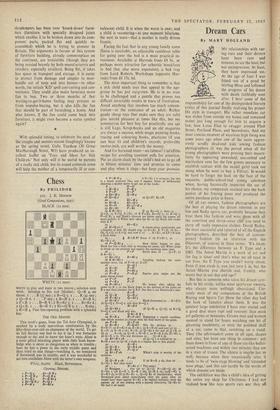Chess
By PHILIDOR-
217. J. K. HEYDON (Good Companions, 1920 BLACK (x2 men) WHITE (11 men) WHITE LO play and mate in two moves ; solution next week. Solution to No. 216 (Moller) : Q—R 4, no threat. i . R (5) any; 2 B—Q 5. I • • • R (4) any, 2 Q—B 6. . . . P any ; 2 B--B 2. . . B—B 6; 2 P x B. x . . . B—R 8 ; a R—Kt 5. i . B—Kt 6; 2 Q x R. . . B--K 6 ; 2 Kt—Q B 3. B else ; 2 R—B 4. Fine line-opening problem with a splendid key. THE OLD MASTER This week's game, from the Tel Aviv Olympiad, is marked by a truly marvellous combination by the fifty-three-year-old ex-champion of the world. To get its full flavour one had to see it (as I was fortunate enough to do) and to know the loser's style. Aloni is a most gifted attacking plityer with little book know- ledge who is never so dangerous as when in trouble ; here he lost a pawn in the early middle game and then tried to mix things—watching it, we wondered if Botwinnik was in trouble and it was wonderful to see him annihilate Aloni with the latter's own weapons.
White, ALoNi. Black, BOTWINNIK.
P 2P 3
4 IC
5 p.— Opening, BENONI.
B 3 P—Q B 4 P—K K 3 83 P-.-Q3 4 B—Kt
6 P—K R . . .
6 B—Kt 5 is stronger, but this
3
ia a much analysed line, and I suspect Aloni of deliberately choosing a weaker move to get out of the books.
6 ._. . 0-0 7 B—K 3 P—K 3 B xP
9 8 KP t—xPB 3 .Q—R 4 zo Q—Q .2 . . . so QxP?, Kt xP. so. . . Kg—Hi zr B—K 2 Kt-422 la 0-0 Rg(2)—K 4
13 Kt x Kt P x Kt
rs K R—Q r . . . If 14 Kt—Q '5, then 14 . . • Q xQ•' T5 B xQ, B xKt; 16 B PxKt, Kt--7Q 5; 17 B—Q 3, P—Q Kt 4 and Black's chances are better since his pawns arc more mobile: if White later takes the Kt on Q5 Black will retake with K P.
24 • • • Kt—Q 5 is B—Q 3■2P . .
A rotten move positionally and
, a blunder as well. He should play s5 B x Kt, K F' x B; 16 Kt— Q5, Q x Q; r7 R x Q; and now if r7 ... B x Kt; a KP x13 with a dead draw.
8 B xR P1 Since if 16 P xB? ?, 16 . . . Kt—H.6 ch.
r6 P—Q 10 1. . . Now Aloni begins to play. Black has lost a little time in winning his pawn, and White plays to break up the position and exploit the resulting open lines. .t6 . . . Px P Better than z6 . . . Q x P; r7 K R—Kt t.
17 Kt—Q 5 B—Kt 5 r8 K R—Kt r . . . Avoiding making the same mistake twice, viz. 18 P—B 3?, B *PI 18 . . P>Q72 1 19 B X.K1 20 R x P P—Kt 3 2l P—R 4 P—B 41 Passive play might sec the
game swing round.
22 P xP BxP
23 P—R s P x P
as R—Kt s • . . . He hopes, after taking the pawn on R 5, to pin Black down to the defence of his pawn on R 2 and then advance the Q B P. But that is not Botwinmk's idea 24 • • • B xB as Q x B Q—R 51
a6 P—Kt 3 Q—Kt 5
27 R—K r . . . Black threatened 27 ... R—B 6; 28 Q—Q 2 P—Q 6, and then B—Q 5. R—B 6 28 Q—lit r . . . 28 Q-1( 4, Q X Q; 29 R x Q, POkil m6.„—. .lcand :lack will win. a Q R—K /3 z a R it P cull Beginning a superb combina- tion which reaches its climax with the final move of the game. 90 P xR Efia, ch .11 K—R z 611 Not the obvious 31 . . R—I3 7?; 32 R—Kt ech7g—B x; 341 II xl3 chl and now (a) 3..3 • • • K x B; 34 R—B 4 ch_,1 R it R;35 —Kt 8 chl and 36 Q it R, or (12 33 • • • R X 13_; 34 Q—K 1, ft— 7; 35 R—K 8 ch, K—Kt 2; 3 Q—K 5 ch. 'The text threatens 32 ... Q—B 6 ch. 32 Kt—K 7 ch' . . 32 r is refuted by 32 ... R—B 7 and 32 Q—Ks leads to a sim ar line to that played. 32 • • •_. K—R r 33 —K 1 33 54 K—ixKpt ch . —..QR 6ch
7!
White's play is worthy of the occasion.
35 • • • Px Kt 36 Q—R 4 ch . . . If 36 R—R 4 ch, then 36 . . .
K—Kt a. But what now? ..
36 . . . K—Kt 11 1 The same! 37 Resigns . . . For (a) 37 cr, P—Q8.act ch• 38 K—Kt 2 (38 K—R 2, R-13 7 ch), B 8 ch; 139K—Kt 3, R—B6 ch, Of (b) 37 R—Kt r, Q—Q t 61 Incidentally, when Botwinnik (was asked immediately after the game what he would have done against R—Kt a he replied instantly (with the
patient air of one dealing with a mental defective), `Q—Kt 6.' He had it all taped.

































 Previous page
Previous page